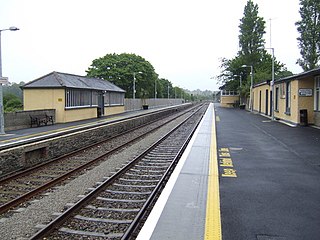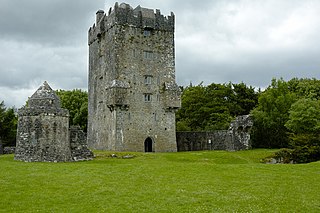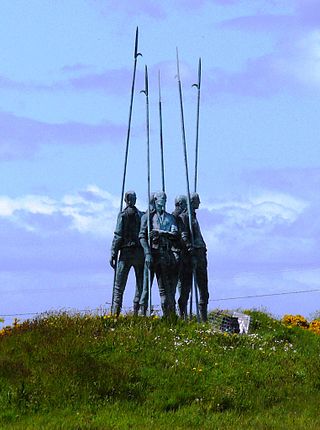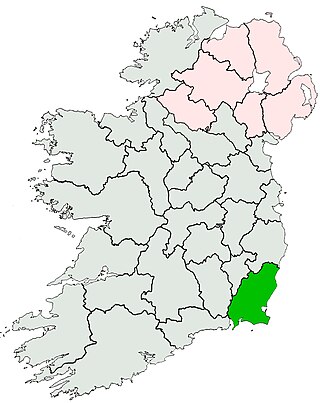
County Carlow is a county located in the Southern Region of Ireland, within the province of Leinster. Carlow is the second smallest and the third least populous of Ireland's 32 traditional counties. Carlow County Council is the governing local authority.

County Wexford is a county in Ireland. It is in the province of Leinster and is part of the Southern Region. Named after the town of Wexford, it was based on the historic Gaelic territory of Hy Kinsella, whose capital was Ferns. Wexford County Council is the local authority for the county. The population of the county was 163,527 at the 2022 census.

New Ross is a town in southwest County Wexford, Ireland. It is located on the River Barrow, near the border with County Kilkenny, and is around 20 kilometres (12 mi) northeast of Waterford. In 2022 it had a population of 8,610 people, making it the fourth-largest town in the county.

Ferns is a historic town in north County Wexford, Ireland. It is 11 km (7 mi) north of Enniscorthy. The remains of Ferns Castle are in the centre of the town.

Dunamase or the Rock of Dunamase is a rocky outcrop in County Laois, Ireland. Rising 46 metres (151 ft) above a plain, it has the ruins of Dunamase Castle, a defensive stronghold dating from the early Hiberno-Norman period with a view across to the Slieve Bloom Mountains. It is near the N80 road between the towns of Portlaoise and Stradbally.

Enniscorthy is the second-largest town in County Wexford, Ireland. The town is located on the picturesque River Slaney and in close proximity to the Blackstairs Mountains and Ireland's longest beach, Curracloe.

Fethard-on-Sea or Fethard is a village in southwest County Wexford in Ireland. It lies on the R734 road on the eastern side of the Hook peninsula, between Waterford Harbour and Bannow Bay.
John Kelly lived in the town of Killanne in the parish of Rathnure, west of Enniscorthy, in County Wexford in Ireland, and was a United Irish leader who fought in the Irish Rebellion of 1798. Kelly was obviously well known to rebels and loyalists alike during the short duration of the Wexford Rebellion but almost nothing is known of him outside this time. He was one of the leaders of the rebel victory at the Battle of Three Rocks which led to the capture of Wexford town but was later seriously wounded while leading a rebel column at the Battle of New Ross.

Enniscorthy railway station is a railway station in County Wexford, Ireland. It is in the centre of the town of Enniscorthy.

John Murphy was an Irish Roman Catholic priest of the Roman Catholic Diocese of Ferns, who is mainly remembered for his central role in the Irish Rebellion of 1798 in County Wexford, which is sometimes known as the Wexford Rebellion. He led the rebels to one of their initial victories over a government militia at Oulart Hill, and in the following weeks became one of the rebellion's main leaders.

Aughnanure Castle is a magnificent tower house near Oughterard on the N59, in County Galway, in the west of Ireland. It was built by the O'Flaherty family in the late 15th century and fully restored in the 1960s. Today it welcomes visitors from March to November, and guided tours are available if booked in advance.
Beauchamp Bagenal Harvey was a barrister and a commander of the United Irishmen in the Battle of New Ross during the 1798 Rebellion.

The Wexford Rebellion refers to the events of the Irish Rebellion of 1798 in County Wexford. From 27 May until 21 June 1798, Society of United Irishmen rebels revolted against British rule in the county, engaging in multiple confrontations with Crown forces. The most successful and destructive rising in all the counties of Ireland, United Irishmen rebels experienced a number of early successes in the county despite being seen as a relatively loyal county by the Dublin Castle administration due to a series of military victories. However, the tide soon turned against the United Irishmen in Wexford as Crown forces poured into the region, engaging in a brutal counterinsurgency which indiscriminately targeted suspected rebels and eventually suppressed all rebel activities in the county.

Duncormick or Duncormac is a rural village and surrounding community located in County Wexford, Ireland. At the time of the 2016 census, the village of Duncormick had a population of 116 people. The village is 18 kilometres (11 mi) south-west of Wexford town, close to the fishing village of Kilmore Quay which is one of the largest fishing harbours in Ireland. 'Duncormick' is sometimes used to refer not only to a village, but also to the rural area surrounding it.

County Wexford is a county located in the south-east of Ireland, in the province of Leinster. It takes its name from the principal town, Wexford, named 'Waesfjord' by the Vikings – meaning 'inlet (fjord) of the mud-flats' in the Old Norse language. In pre-Norman times it was part of the Kingdom of Uí Cheinnselaig, with its capital at Ferns.
Maud de Prendergast, Lady of Offaly, was a Norman-Irish noblewoman, the first wife of Maurice FitzGerald, 3rd Lord of Offaly, Justiciar of Ireland, and the mother of his two daughters, Juliana FitzGerald and Amabel. She married three times; Maurice FitzGerald, 3rd Lord of Offaly was her third husband.
The High Sheriff of Wexford was the British Crown's judicial representative in County Wexford, Ireland from the 16th century until 1922, when the office was abolished in the new Irish Free State and replaced by the office of Wexford County Sheriff. The sheriff had judicial, electoral, ceremonial and administrative functions and executed High Court Writs. In 1908, an Order in Council made the Lord-Lieutenant the Sovereign's prime representative in a county and reduced the High Sheriff's precedence. However, the sheriff retained his responsibilities for the preservation of law and order in the county. The usual procedure for appointing the sheriff from 1660 onwards was that three persons were nominated at the beginning of each year from the county and the Lord Lieutenant then appointed his choice as High Sheriff for the remainder of the year. Often the other nominees were appointed as under-sheriffs. Sometimes a sheriff did not fulfil his entire term through death or other event and another sheriff was then appointed for the remainder of the year. The dates given hereunder are the dates of appointment. All addresses are in County Wexford unless stated otherwise.

Wexford Bridge is a road bridge in Wexford, the county town of County Wexford in Ireland. It crosses the mouth of the River Slaney from Wexford town on the west bank to Ferrybank on the east bank. It carries the R741 road from Wexford towards Dublin and the north. The bridge consists of 7 spans of maximum length 63 metres and 12 metres wide, made of continuous steel girders carrying composite concrete slabs. Including the approach roads, the total length of the bridge is 590 metres, of which 380 metres are over water.
National 1798 Rebellion Centre is a heritage centre dedicated to the history of the 1798 Rebellion located in Enniscorthy, County Wexford.

Johnstown Castle is a Gothic Revival castle located in County Wexford, Ireland.

















